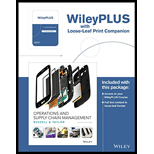
Concept explainers
a)
To determine: number of necklaces and bracelets to produce maximum profit of the jewellery shop by formulating linear programming and solve it.
Introduction: Linear programming is used to obtain the best possible outcome from the given real-world problem which is subjective to constraints and inequalities. It is used to make decisions based on business objectives. It is used in business planning, industrial engineering, and physical science. Express the real-world problem into the mathematical expression to get the optimal solution from the linear programming.
b)
To determine: if the store produces the maximum bracelet and necklace will it meet the maximum demand for the bracelet.
c)
To determine: profit for the necklace would result in no bracelet being reduced.
Want to see the full answer?
Check out a sample textbook solution
Chapter 14 Solutions
Operations and Supply Chain Management, 9th Edition WileyPLUS Registration Card + Loose-leaf Print Companion
- Not use ai pleasearrow_forwardWhat is Bitcoin? How important is it to businesses and individuals? How does it cause environmental damage and is that damage worth continued uses of Bitcoin? Read the following articles to help answer these questions: United Nations University. (2023, October 24). UN study reveals the hidden environmental impacts of bitcoin: Carbon is not the only harmful by-product. https://unu.edu/press-release/un-study-reveals-hidden-environmental-impacts-bitcoin-carbon-not-only-harmful-product#:~:text=Bitcoin%2C%20the%20most%20popular%20cryptocurrency,the%20worldwide%20Bitcoin%20mining%20network. Salam, E. (2023, April 26). Bitcoin is terrible for the environment – can it ever go green? The Guardian. https://www.theguardian.com/technology/2023/apr/26/bitcoin-mining-climate-crisis-environmental-impactarrow_forward419 X .com/courses/1546/assignments/49499?module_item_id=111573 Unlimited Attempts Allowed ✓ Details Directions: Record a video of yourself giving a business presentation. Imagine you are tasked with researching a professional development topic on business communication for 40 coworkers. You are then expected to give a 4 - 5 minute presentation on the topic. Choose any topic related to business communication, such as intercultural communication, effective leadership, professional writing, etc. Research the topic and prepare a 4 - 5 minute presentation that could be given over video conference call (such as Zoom). You may use visual aids if you choose. Upload a video file of your presentation. Provide all needed citations. Requirements: 4-5 minutes long Contains visual and audio Create your own work; do not plagiarize Cite your sources using APA citations Choose a submission type Tarrow_forward
- acts Container chips (s 150 cussion: Conflict X + e.com/courses/1546/discussion_topics/15722?module_item_id=111559 24 Winter > Discussions > Week 8 Discussion: Conflict 时☆ 26 Replies, 26 Unread Week 8 Discussion: Conflict Write a 200 - 300 word discussion post based on the prompt below. Reply to at least one other student in 50 - 100 words. Can you think of a time when a conflict led to a new opportunity, better understanding, or other positive result? If not, think of a past conflict and imagine a positive outcome. Discuss the impact of this conflict on your workplace relationships, productivity, and innovation. Source: Business Communication for Success. (2015). University of Minnesota Libraries Publishing. Attribution-NonCommerical-ShareAlike. Edit View Insert Format Tools Table 12ptv Paragraph BIUA T2arrow_forwardHow would you design and implement a modern networking solution for JAMS Manufacturing to connect all their facilities and ensure seamless communication? The company currently has standalone systems in three manufacturing plants and an office building, each using its own modem or router for internet access. The goal is to create private networks for each location, connect them to one another, and provide Internet access to all. You’ll need to consider factors like new computer systems, servers, and telecommunications wiring, and explain how your solution will benefit the company and how it will be implemented effectively.arrow_forwardIdentify specific performance management processes covered in this course and how each aligns with an elements of LaFevor’s HCMS Model.arrow_forward
- Identify specific performance management processes covered in this course and how each aligns with LaFevor’s HCMS Model. LaFevor, K. (2017). What’s in Your Human Capital Management Strategy? The Game Plan, the Path, and Achievingarrow_forwardassess how Human Capital Management Strategy is aimed at building an effective integrated performance management system: Discuss how human capital management strategy relates to performance management.arrow_forwardCASE STUDY 9-1 Was Robert Eaton a Good Performance Management Leader? R obert Eaton was CEO and chairman of Chrys- ler from 1993 to 1998, replacing Lee Iacocca, who retired after serving in this capacity since 1978. Eaton then served as cochairman of the newly merged DaimlerChrysler organization from 1998 to 2000. In fact, Eaton was responsible for the sale of Chrysler Corporation to Daimler-Benz, thereby creating DaimlerChrysler. With 362,100 employees, DaimlerChrysler had achieved revenues of €136.4 billion in 2003. DaimlerChrysler's passenger car brands included Maybach, Mercedes-Benz, Chrysler, Jeep, Dodge, and Smart. Commercial vehicle brands included Mercedes-Benz, Freightliner, Sterling, Western Star, and Setra. From the beginning of his tenure as CEO, Eaton communicated with the people under him. He immediately shared his plans for the future with his top four executives, and upon the advice of his colleague, Bob Lutz, decided to look around the company before making any hasty…arrow_forward
- Critically assess Martin’s coaching style.arrow_forwardCompare Robert Eaton’s performance management leadership presented in the case against the performance management leadership principles, functions, and behaviors. What recommendations can be made about what he might do more effectively? Explain and defend your answer.arrow_forwardIn the context of the material in Chapter 9, provide a critical analysis of the decisions that Henry has made in assigning Martin to this role.arrow_forward
 Practical Management ScienceOperations ManagementISBN:9781337406659Author:WINSTON, Wayne L.Publisher:Cengage,
Practical Management ScienceOperations ManagementISBN:9781337406659Author:WINSTON, Wayne L.Publisher:Cengage,
